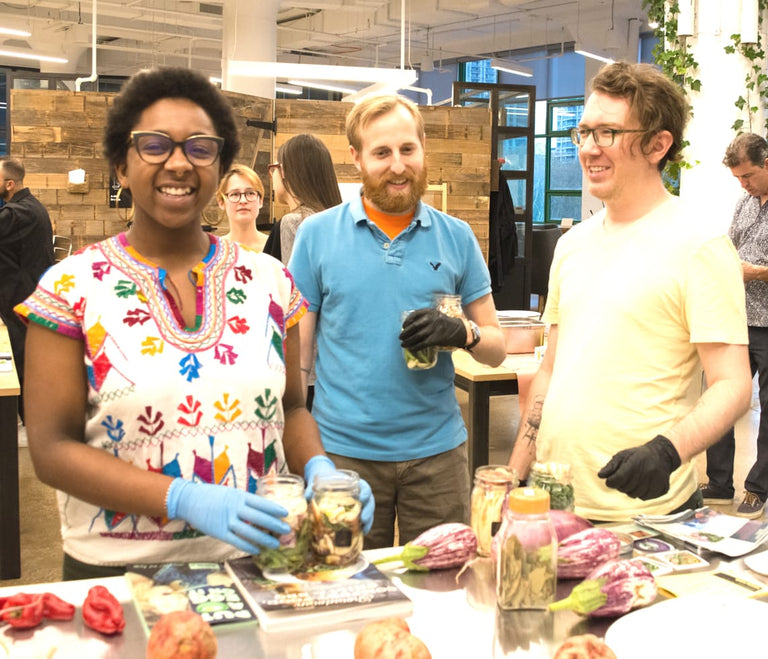How to Buy, Store, and Cook a Pasture-Raised Turkey

The push and pull between preference and tradition is enough to complicate any holiday, especially one as food-centric as Thanksgiving. This begs the question none of us want to face, but that all of us think about at one time or another: do we actually enjoy the foods we eat, or do we eat them because they’re what we’ve always eaten? In simpler terms, do we even like turkey? If you’re like 65% of Americans, you find turkey dry, and quite frankly, you’d prefer another bird to be the centerpiece of your holiday table. And for whatever the reason, Americans are eating less (and craving less) turkey on our annual turkey day, now more than ever.
The good news? Everyone around the table will rejoice to hear that turkey doesn’t have to be dry, hackneyed, outdated, or even overplayed. This year, Local Roots has put together the ultimate guide in order to teach you (that’s right, you) how to take turkeys from tired to tantalizing in a matter of hours. Just follow these simple, riffable steps, and you’ll be on your way to poultry paradise.
Something to keep in mind before starting this journey? All birds are different. Turkeys vary in weight, shape, and other idiosyncratic features, making this guide exactly that—a guide. The reality is that not all recipes take into account the fact that not all birds are the average 15 pound weight, and they sure as heck don’t fit a one-size-fits-all treatment.
As it turns out, one static temperature doesn’t help much either. In fact, it can end up hurting quite a bit. Breast meat tends to dry out when it reaches a temperature above about 145 or 150 degrees, whereas leg meat should be cooked to around 165 for the best results. So how do you cook your turkey for ultimate juiciness?
Buying the Bird
Before we get ahead of ourselves, let’s talk turkey at its most basic level: breed. Most Thanksgiving turkeys are butterball-type birds (hybrids) which are bred to get fat quickly, a goal that is achieved with formulated feed in climate controlled barns. These turkeys are grown in just twelve weeks, making this growth-period profitable with a fast turn-around time to boot. This expedited process allows factory farms to produce as many as 30,000 birds per holiday season.
But these bargain-birds come with a catch: the majority of these turkeys are given less than 3 square feet of living space, and can have some pretty adverse effects on the health of our planet, too. Some factory turkey farms collect animal waste in football field-sized, open-air lagoons that can tarnish and contaminate nearby water supplies when over-applied to the land, according to the USDA. Not to mention, the gallons of water used to produce a pound of turkey at a factory farm equals the same amount of water the average American uses in 100 showers.
But there is another option. Unlike the 30,000 bird-per-season rate of factory farms, many local farms raise about 50 to a few hundred birds at a time, where each turkey receives attentive care to keep it as healthy as it can be. And health, believe it or not, has a direct and positive impact on flavor. These birds, often classified as either pasture-raised or heritage breed, grow much more slowly than hybrid turkeys like butterballs, allowing them to develop deeper and better flavor profiles than the mass-produced type, making them the obvious choice for a multitude of reasons.
Knowing the Difference
Understanding the difference between conventional and pasture-raised or heritage breeds is half the battle in terms of yielding the most flavorful, succulent result possible. Meat from pasture-raised and heritage turkeys has more color (in both white meat and dark meat). This depth of pigmentation, which experts attribute to a result of oxygenation, actually signifies stronger muscle mass, not to mention a much higher concentration of flavor. Of course, non-factory-raised poultry, even faster-growing breeds, are able to develop more muscle mass as they spend their days foraging for food and are free to wander the premises on which they live. Despite taking longer to cook, birds with darker meat beget juicer, more sapid forkfuls.
Turkeys raised on pasture tend to have stubbier legs and larger breasts, a natural occurrence that causes them to look similar to store-bought birds in both shape and proportion. But don’t be fooled. The most major difference between these turkeys is that pasture-raised birds are free to wander outdoors at their own leisure and forage for their own food, making them more active when compared to factory-farmed turkeys. This increased activity, experts say, makes the world of a difference in terms of flavor development. On top of this, any animal raised on pasture is raised with ethics in mind, although not all other farmers can advertise the same.
Moreover, a pasture-raised turkey is not necessarily a heritage turkey. Heritage breed turkeys descend from rarer genetic lines and tend to express more natural behaviors like running, flying, and even mating, resulting in overall smaller breasts and stronger legs. Their carcasses look incredibly different from those of other turkeys, as they are known for having legs and breast bones twice as long as those of store-bought and other birds. Be mindful of the fact that these birds taste noticeably gamier, and are, by comparison, much more expensive than their pasture-raised and store-bought cousins.
Overall, pasture-raised turkeys are the most balanced in terms of flavor, price-point, and adaptability, which is why this Thanksgiving, Local Roots has decided to offer some seriously legendary pasture-raised turkeys to its customers. This year’s turkeys come from our friends at Oink & Gobble Farm, a local turkey farm based in Interlaken, New York whose delicious turkeys are raised on pasture and fed a mix of non-GMO corn and roasted soybeans free of added antibiotics or hormones. Head to the Thanksgiving Harvest tab on our website to place your order for an Oink & Gobble pasture-raised turkey, and now, for a limited time, get $15 off Thanksgiving vegetable orders when you order your bird by October 23rd. Just checkout with the code: thankfulforveg!
Storing the Bird
Now, onto one of the more controversial steps of Thanksgiving preparedness: storage. Since the advent of modern refrigeration and freezing, home cooks have lamented upon the simplicity of “just defrosting” whatever it is they might be venturing to cook. Now, it’s more common than ever to find frozen anything in the supermarket, and that includes turkeys. And while it might be a whole lot easier to take a rock-hard bird out of the freezer a few hours before cooking and save some of that precious fridge space for all the other dishes that will inevitably dot your holiday table—resist the temptation!
Freezing meat creates ice crystals that damage cell structure, plus frozen meat of any kind is more prone to moisture loss than fresh meat, says the Food Lab at Serious Eats. The team found that frozen meat can lose up to 12% more moisture than fresh when cooked, which is no small margin, especially when dealing with turkey. Even turkeys sold “fresh” may have been frozen and thawed before sale, so beware and do yourself a favor: stay away from shortcuts; your guests will thank you for it. And if, for whatever reason, you do decide to go the frozen route, make sure to allot six hours per pound to thaw (about three full days before cooking). Fresh turkeys, too, should be cooked within the same three day period after unpacking them in to optimize flavor and freshness.
Configuring the Bird
Like we’ve mentioned, there is no standard cooking time for Thanksgiving turkeys because all turkeys are different. With that being said, there are things you can do to ensure juicy meat like brining. Brining combats dryness, and it’s all thanks to one ingredient: salt. Most brines are in the five to eight percent salt range by weight which allows the turkeys to retain moisture even after the cooking process. As unlikely as it may seem, brined meat can store 30 to 40% more moisture than non-brined meat, and in terms of turkey breast, brines can have up to a 10% impact on moisture retainment which is no small feat. The Food Lab explains it this way:
“When you salt a turkey (or chicken) breast, meat juices are initially drawn out through the process of osmosis. As the salt dissolves in these juices, it forms what amounts to a very concentrated brine, which then allows it to break down muscle proteins. The loosened muscle fibers allow the juices to get reabsorbed, this time taking the salt along for the ride.”
But not all brines are made equal. In the past, wet brines have been coveted as a method which adds moisture into protein, which isn’t false. Here’s where it gets a little more complicated, though: recent experiments have shown that while wet brines do contribute to increased moisture content (in some cases up to 10% of the initial weight), a lot of that moisture comes from water. Despite the fact that wet brines are solutions made up of salt, sugar, and plenty of other spices that are intended to impart better texture and flavor to meat, the juices that release from wet-brined meat are largely just… watery. Now, that kind of juiciness doesn’t do much for us in terms of deliciousness, and it sure as heck isn’t the ideal base for a good gravy either. Besides, wet brines take up an exorbitant amount of space in the refrigerator, complicating things even further.

Introducing: the dry brine. Far simpler than submerging a 15 pound bird into a vat of water and spices, this method requires only the latter ingredients, and comes together much less messily. Using far less salt and sugar than wet brines, dry brines boast one particular superiority: direct contact. Seasoning the turkey directly allows tailored amounts of sugar and salt to penetrate the skin and fibers more effectively, and in less time, too. Research tells us that muscles, which are essentially long bundles of fibers protected by tough shields of protein, are prone to shrinkage and weight loss when exposed to heat. Salt is heroic in counteracting this loss of mass, and it does its best and most effective work when introduced in a dry brine. Not to mention, whereas most wet brines can take up to three days, the majority of dry brines only take about one, sparing time and stress in the preparation process.
Any way you look at it, all signs point to dry-brining as the way to go. So scrap the industrial-sized tub, and make room in the fridge for other produce, because the dry brine won’t need any of that to make your turkey stand out. Simply set a timer for around 24 hours, and let the rub do the work.
Prepping the Bird
Despite not being the most traditional configuration, experts agree that spatchcocking is the fastest and most efficient method for cooking a whole turkey. What is spatchcocking, you ask? Sometimes called butterflying, spatchcocking is the method of removing the backbone of the bird (the term originates as shorthand to “dispatching the cock”) and opening the carcass to improve and hasten the cooking process by about half. Spatchcocked birds have more surface area, too, which means better and more even browning, not to mention crispiness, making this a popular method for good reason.
To spatchcock the bird, begin by cutting out the backbone using shears, taking care to cut along either side of the bone beginning at the tail end. Don’t forget to save that backbone for later on! It’ll serve as a remarkable base for a rich, spoon-coating gravy. Then flip the turkey so that it faces breast-side upward, and press down firmly on the breast bone with the heel of your hand until the bone cracks and the carcass flattens. Before beginning the cooking process, be sure to tuck the wing tips under the turkey so that they don’t burn or cook too quickly.
(Tip: You can stuff a spatchcocked bird by placing the stuffing directly under the cavity.)
Cooking the Bird
Now that we’ve covered the rest, it’s time to tackle the main and perhaps highest stakes step: actually cooking the bird. Like those who’ve guessed before us, poking at thighs to check their doneness, let’s agree to, this year, trust our thermometers (stock up on one here!) and not our instincts for the sake of accuracy. It’s tricky business, cooking a bird, mostly due to the fact that its limbs vary in size and therefore run the gamut of temperature requirements. Let’s not complicate it any further by factoring guesswork into the equation.
Heritage Foods USA stipulates a 325-degree oven temperature to allow the fats to render, which is a more low and slow approach to cooking the turkey than many hosts may be used to. The reason for this is that slow roasting is ideal for minimizing moisture loss and maximizing tenderness. Higher temperatures, on the other hand, increase the chances for burning and overcooking, as well as uneven cooking.
Checking both the deepest part of breasts and that of the thighs, make sure the breasts register at 150-degrees and the legs register at least 165-degrees. These temperatures, according to the experts at Serious Eats, are the sweet spot for tender, moist meat that is both flavorful and textured to perfection.
(Tip: Just before the meat registers to its stipulated temperatures, crank up the heat to 400 or 425 to crisp the skin even further.)
Final Notes
Just in case you’re thinking of serving your now-perfectly-cooked turkey using some old techniques (like sticking oodles of butter between the flesh and skin), let’s go over a few little-known, ever-important tips:
1. Bolster your dry-brine with a little baking powder! Including baking powder into the salt, sugar, and spice mix for your rub will go a long way in terms of providing the most crispy skin achievable, yielding a crunchy texture most home cooks have only dreamt of.
2. No butter (and that means not before, during, or after the cooking process). Butter may add flavor to the turkey skin and meat, but also takes away from its crispiness, not to mention increases its overall oiliness, too.

3. Preheat your stuffing! Because stuffing your bird can have a pretty rousing impact on its internal temperature, you’ll need to be extremely careful when considering the doneness of the turkey. Stuffing may absorb the juices released in the internal cavity, but that doesn’t mean that it’ll reach a safe final temperature at the same rate or time as the bird itself. The solution? Preheat the stuffing (in the microwave is fine) and wrap it in a cheesecloth before placing it inside the turkey (165-degrees is a safe temperature at which stuffing can be considered cooked through, says the USDA).
4. Gravy should be made using as many miscellaneous turkey parts as possible. If you’ve spatchcocked your bird, you’ll be able to use the backbone to inform the flavor of what will inevitably be a rich, toothsome gravy. If you haven’t spatchocked your turkey, though, don’t worry; there’s still plenty of giblets and neck that will be just heavenly in your homemade gravy. (Local Roots turkeys come with both their giblets and neck included for this very reason!) Brown whatever turkey parts you’re using (with the exception of bone), throw in some classic aromatics (onion, carrot, celery, bay leaves, and black peppercorns are all viable options), and top it off with enough homemade (or store-bought) stock to cover, letting your fragrant concoction simmer for at least an hour. Before serving, discard the solids, and incorporate any leftover drippings from the bird itself.
5. Let your turkey rest! Time constraints and pure lack of will power often leave us skipping this crucial step, causing us to rush in knife-first to reveal our juicy, tender creation. Trust us when we say that resting is not optional; it is imperative to allowing the bird to retain its internal juices, ensuring all those moisture-retaining techniques from before aren’t put to waste. 20 to 30 minutes is the recommended time for allowing your meat to take a break, but we won’t tell if you wind up choosing the former, shorter wait-time, whatever the reason may be.
6. Lose the electric knife. Besides being an unsightly spectacle and a pain in the back to store and operate, the electric carving knife pales in comparison to a plain old chef’s knife which gets the job done just as well without the frustrating tendency to over-carve or miscut. So, do yourself a favor and keep things simple this year, especially on this, the final step standing between you and your best Thanksgiving turkey yet.
Article by Local Roots Volunteer Jess Santoro (@jess_santoro)
Rather have a taste first?
Local Roots Experiences are fun, pop-up events where we bring the farm to you!

Become a Harvest Club Pick Up Location
Are you a NY based cafe, bar, or neighborhood business? Become a Harvest Club pick up location and have community members come to your establishment each week to pick up their Local Roots harvest.
Top






